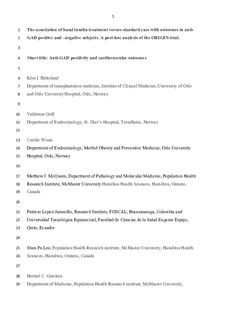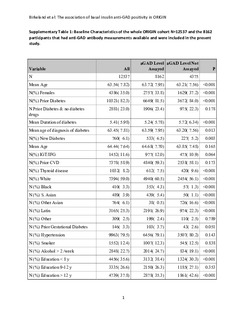| dc.contributor.author | Birkeland, Kåre I. | |
| dc.contributor.author | Grill, Valdemar Erik Robert | |
| dc.contributor.author | Wium, Cecilie | |
| dc.contributor.author | McQueen, Matthew J. | |
| dc.contributor.author | López-Jaramillo, Patricio | |
| dc.contributor.author | Lee, Shun Fu | |
| dc.contributor.author | Gerstein, Hertzel C. | |
| dc.date.accessioned | 2019-03-20T06:47:49Z | |
| dc.date.available | 2019-03-20T06:47:49Z | |
| dc.date.created | 2018-10-26T14:07:52Z | |
| dc.date.issued | 2018 | |
| dc.identifier.citation | Diabetes, obesity and metabolism. 2018, 1-5. | nb_NO |
| dc.identifier.issn | 1462-8902 | |
| dc.identifier.uri | http://hdl.handle.net/11250/2590720 | |
| dc.description.abstract | We compared cardiovascular and other outcomes in patients with dysglycaemia with or without anti‐glutamic acid dehydrogenase (GAD) antibodies participating in the Outcome Reduction with Initial Glargine Intervention (ORIGIN) trial. Of the 12 537 participants, 8162 had anti‐GAD measured at baseline and 267 were anti‐GAD positive. The effects of insulin glargine versus standard care and of n‐3 fatty acids supplements versus placebo were compared by testing the interaction of the treatment effects and anti‐GAD status. The effect of glargine on development of new diabetes was assessed in participants without previous diabetes at baseline. The overall incidence of outcomes did not differ between anti‐GAD positive and anti‐GAD negative subjects. The incidence of the composite of cardiovascular death, non‐fatal myocardial infarction, or non‐fatal stroke did not differ between anti‐GAD positive participants randomized to insulin glargine or to standard care, with a hazard ratio (HR) (95% confidence interval [CI]) of 0.80 (0.44‐1.44) or in anti‐GAD negative participants with a HR of 1.07 (0.96‐1.20) (P for interaction = 0.20). | nb_NO |
| dc.language.iso | eng | nb_NO |
| dc.publisher | Wiley | nb_NO |
| dc.title | The association of basal insulin treatment versus standard care with outcomes in anti-GAD positive and negative subjects: A post-hoc analysis of the ORIGIN trial | nb_NO |
| dc.type | Journal article | nb_NO |
| dc.type | Peer reviewed | nb_NO |
| dc.description.version | acceptedVersion | nb_NO |
| dc.source.pagenumber | 1-5 | nb_NO |
| dc.source.volume | 21 | nb_NO |
| dc.source.journal | Diabetes, obesity and metabolism | nb_NO |
| dc.source.issue | 2 | nb_NO |
| dc.identifier.doi | 10.1111/dom.13528 | |
| dc.identifier.cristin | 1623919 | |
| dc.description.localcode | Locked until 10.9.2019 due to copyright restrictions. This is the peer reviewed version of an article, which has been published in final form at [https://doi.org/10.1111/dom.13528]. This article may be used for non-commercial purposes in accordance with Wiley Terms and Conditions for Self-Archiving. | nb_NO |
| cristin.unitcode | 194,65,15,0 | |
| cristin.unitname | Institutt for klinisk og molekylær medisin | |
| cristin.ispublished | true | |
| cristin.fulltext | original | |
| cristin.qualitycode | 1 | |

